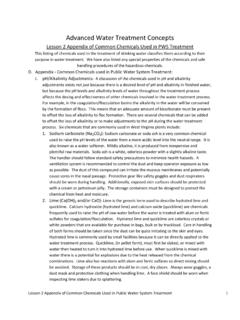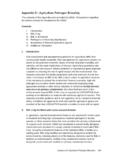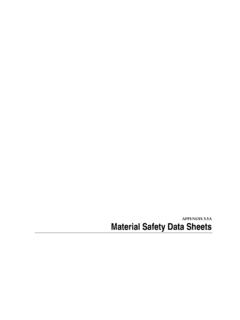Transcription of APPENDIX 1 - Use of gloves
1 ACDP/92/P5f - APPENDIX 1. APPENDIX 1 - USE OF gloves . Within the hierarchy of controls recommended by COSHH (2002)1, elimination and engineering controls should have priority over the use of personal protective equipment, including the use of gloves . However, where it is not possible to achieve adequate control by other means alone, personal protective equipment including gloves should be used in combination with and in addition to other controls. In practical terms, gloves will play an important part in protecting workers from exposure to blood borne viruses, especially where there is a risk of injury such as a puncture wound with contaminated sharps, or abrasions or cuts. It is likely to be in the laboratory and healthcare sectors where staff are at greatest risk of exposure.
2 Also, the Advisory Committee on Dangerous Pathogens (ACDP) guidance The management, design and operation of microbiological containment laboratories (HSE, 2001). recommends that gloves should be worn for all work with material known or suspected of containing hazard group 3 biological agents and that a supply of suitable disposable gloves in various sizes and materials should be available in the laboratory 2. The main considerations are: What gloves to wear appropriate to the work being done and the materials being handled, and How to remove gloves safely to prevent potential cross-contamination. What gloves to wear? The gloves worn should be able to provide protection from exposure to blood borne viruses for the duration of the tasks being undertaken.
3 This may mean having to change them safely mid task if they become damaged and/or having to wear a combination of more than one type of glove to provide additional physical protection. For example: General hospital work or work in a laboratory is likely only to require disposable medical gloves (also known as medical examination gloves , exam gloves and surgical gloves ). In certain circumstances, double gloving may be required to provide additional protection. This allows for removal and replacement of the outer gloves , if contaminated, while still retaining skin protection. A review of this and related approaches to glove 1. HSE (2002). Control of substances hazardous to health. The Control of Substances Hazardous to Health Regulations 2002.
4 Approved Code of Practice and guidance L5 (Fourth edition) HSE Books ISBN 0 7176 2534 6. 2. HSE, Advisory Committee on Dangerous Pathogens (2001). The management, design and operation of microbiological containment laboratories. HSE Books ISBN 0717620344. 1. use was unable to confirm that additional glove protection worn by surgical teams reduced surgical site infections in patients. However, the addition of a second pair of surgical gloves was found to significantly reduce perforations to the wearer s innermost gloves3. The same review concluded that, for some surgical work , orthopaedic or dentistry, where additional physical protection may be needed, double gloving, the use of glove liners or of knitted or steel weave outer gloves may be appropriate and are proven to be beneficial For some work, such as post mortem or embalming, where there is a risk of exposure to blood borne viruses as well as the requirement to use knives, saws etc.
5 , pierce and cut resistant gloves are likely to be needed in addition to those providing microbiological protection. When choosing protective gloves , look for the following information: European Standards for personal protective equipment (PPE) demonstrate their conformity with the basic health and safety requirements of the EC. Personal Protective Equipment Directive. Only equipment meeting these requirements is entitled to carry a CE mark and be sold for use in the EC. EN 420:2003- General requirements for gloves , supplemented by (as appropriate): EN 388:2003 - Protective gloves against mechanical risks (abrasion resistance, blade cut resistance, tear resistance, puncture resistance);. EN 1082-1:1997- Protective clothing - gloves and arm guards protecting against cuts and stabs by hand knives: Chain mail gloves and arm guards.
6 EN 374-1:2003 - Protective gloves against chemicals and microorganisms. As for EN 420 and EN 388, plus gloves resisting microorganisms must achieve performance level 2 in penetration. Although this cannot infer protection against virus because they are not used in the performance tests, in practical terms this is the highest level of protection afforded against microorganisms. It is important to look for the above information on glove packs. Some disposable gloves , such as transparent polythene gloves , which may be in use in your workplace, are loose fitting and easily perforated. They will not conform to the above standards, especially for tear resistance, and are not fit for the purpose of protection against exposure to blood borne viruses.
7 Latex allergies are becoming common with prolonged use of latex gloves , and the use of nitrile or vinyl gloves is recommended to avoid becoming sensitised. It is recognized, however, that within certain work environments, latex gloves are still used in large numbers due to their efficacy and relatively 3. Tanner J, Parkinson H. Double gloving to reduce surgical cross-infection (2002). Cochrane Database of Systematic Reviews, Issue 3. Art. No.: CD003087. DOI: Available at: 2. low cost. If latex gloves are worn, then powder free, low protein content materials must be chosen to help prevent latex allergy. Powdered gloves should be avoided as they can increase skin irritation and the likelihood of allergy development.
8 Where latex gloves are in use appropriate health surveillance should be implemented. Further information on latex allergy can be found on-line at: and detailed information on skin care and dermatitis in the work place can be found at: Symbols to look for on glove packs: Mechanical hazards Impact cut Chemical hazards Micro-organism hazards When checking the pictograms for the biohazard protection standards that gloves must meet it is also useful to have information on the level of conformity of the product. If present, this information is typically shown next to the pictogram, in brochures or on packaging. Conformity information may include a numerical performance indicator. If such information is absent, it should be requested from the glove supplier, as it can provide more detail on the suitability of a glove product for specific tasks.
9 How to remove gloves safely When removing potentially contaminated gloves it is important to ensure that you do not transfer the contaminant onto your skin. The following pictorial guides show proven methods for correct removal of gloves to minimise the 3. risk of cross-contamination. They are available to download as posters to put up in your workplace from: and It is important to use one glove to remove the other. With disposable gloves it is best to turn them inside out as they are removed. UV light fluorescent dyes are available as a training aid. To use these, contaminate the outside of gloves with the dye, remove the gloves then examine your hands under a UV light source to check for cross- contamination.
10 To find these products put fluorescent hand hygiene training . in a web search engine. Within the healthcare setting, support staff such as porters and operating department assistants may wear disposable gloves primarily for their own protection, rather than that of the patient. Such staff should ensure they change their gloves before opening doors from one ward to another, and prior to undertaking tasks such as answering the telephone. Failure to do this may result in the transfer of infected material on to other surfaces, potentially leading to contact exposure of other staff, patients and members of the public. 4. Procedure for correct removal, storage and putting on of re-usable gloves : Procedure for correct removal and disposal of single use gloves : 5.













